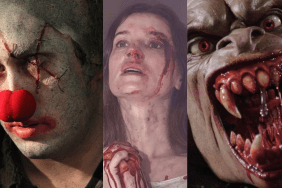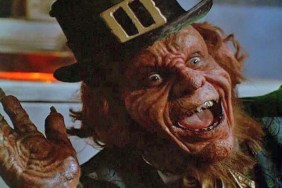
Author Lee Gambin’s SECRETLY SCARY is a celebration of movies that were not marketed as horror films but contain hidden horrors ripe for discovery and discussion.
You know what Id like to do? Id like to go to a nice place and have a drink. – Kirsten Clay
With a tagline reading: In its own terrifying way it is a love story, Blake Edwardss harrowing exploration into the disastrous effects of alcoholism DAYS OF WINE AND ROSES is a devastating character study that reads like a monster movie in that it presents its two leads as desperate loners isolated by their overwhelming addiction. This heartbreaking and bleak doomed romance is written, directed and performed with such bloodletting sensitivity, stark awareness and revelatory sophistication that it is thoroughly gripping and determinedly unsettling. The film sets itself up as a hangover from the romantic comedies of the fifties starring the likes of Rock Hudson and Doris Day, but is painted with such sinister undertones that that entire mood is completely destroyed and swept away as we are swiftly introduced to two characters who hold each other captive as accountable crutches, with a half empty bottle of booze in each hand.
Joe Clay (Jack Lemmon) is in public relations (but considers himself more so a corporate pimp), and he is the kind of guy that is in charge of other peoples happiness and never really considers his own. He is also an alcoholic, but not truly aware of how severe his drinking is. On a job he meets a pretty secretary named Kirsten (Lee Remick) who doesnt touch alcohol, but is nuts about chocolate. After a couple of failed attempts, he finally convinces Kirsten to go on a date with him, and it is here that he buys her a chocolate-flavored drink that she takes a liking to. Joe, like many alcoholics, is desperate to find a devoted drinking partner and sees potential in Kirsten here the film jets off like a vampire movie, in that the original undead (the established boozer) initiates his victim and in turn inducts them into the world of vampirism (alcoholism).
Drinking is the backbone of Joe and Kirstens relationship, and the film details this in a mesmerizing and perpetually engaging manner this is a horror film where addiction, dependence, alienation, sadness, overwhelming loneliness and disconnection all permeate the delicate human condition and where the true monsters emerge from the frail desire to be loved, accepted, warranted and desired.

When Joe first visits Kirstens apartment, armed with bags of booze, he takes on the buildings cockroach problem with bug sprays which infuriates her neighbours. The angry tenants (like angry villagers in a classic Universal horror film) collect along the bannisters of the stairwell shouting out their complaints about the smell of the bug spray which sends Kirsten and Joe into a laughing frenzy and into each others arms. This incredible moment summarises their ill-fated love affair with astounding subversive intelligence, it suggests that Joe Clays drunken feeble attempt to tend to a cockroach infestation instantly ostracizes he and Kirsten, and soon enough as their alcoholism transforms them into hopeless wrecks, their own personal bugs (bought on from the liquor) will control them, torment them and ultimately destroy them.
They are not long the days of wine and roses whispers Kirsten (reciting a poem) as she watches the empty bottle of whiskey she and Joe have shared on a San Francisco pier descend into the watery depths: a profound condensation of her and Joes own personal descent into the depths of uncontrollable alcoholism.
After they are married, Joe and Kirsten have a baby which adds a strain to Joes alcoholism and helps lead to Kirstens reach out to the bottle. In one of the most confronting scenes of the film, Joe returns home after a night working/drinking and he lashes out at Kirsten, screaming at her and demanding that he wants to be allowed to drink but more importantly, that he wants to drink with his wife. What makes it even more monstrous is that before this violent outburst occurs, we are witness to a bumbling Jack Lemmon as Joe Clay crashing into a glass door, having a rose stem get caught in the elevator and coming across as the clown audiences were so used to seeing. But as the scene progresses and the confrontation with his wife gets painfully ugly and scary, it is scarring and horrific. Lemmon, primarily known to cinema audiences for his comedic roles fuelled with jittery neurosis, emerges himself in a warts and all dramatic schizoid which is both difficult and relentlessly depressing to watch. Lemmon is purely spectacular.
The music by Henry Mancini drives the horror home, it seeps in and fouls the atmosphere heightening the distress and torment. The image of a crying, drunk Joe Clay looking over his restless baby in her crib is a depressing image of a man rendered alone if his wife, the convert-to-be, doesnt drink with him. The closing moment of this scene has Kirsten comfort the shambolic Joe as she downs a glass of bourbon. This is her descent into monstrousness and her transformation from demure, quiet, mousy beauty to ravaged and addled harpy who terrorizes Joe later in the film screaming at him Im a woman! Cant you hear me?! in a desperate plea to be looked upon with respect and admiration. She also turns alcoholism into something that is an essential attribute to the makings of a man she yells at the weary eyed Joe who (by the closing moments of the film) has been going to Alcoholics Anonymous meetings, I want someone who has the guts to have a drink!

Lee Remick is phenomenal in a role that undergoes such a dramatic transformation her early moments as the tea-totalling meek secretary cement her as a likeable working class girl, and when she hits the booze in order to keep her man, Remick unleashes a powerhouse of a performance that truly frightens the horses. She delivers an electric counterpart to Jack Lemmons frenzied imp locked in the grips of liquors curse.
The film plays with horror movie tropes in a thought out manner for example, when Joe and Kirsten slip during their few days of sobriety and decide to sneakily drink, they get completely sloshed while an aggressive storm complete with thunder and lightning crashes outside. When Joe ventures out into the storm in order to creep into Kirstens fathers greenhouse to find his hidden stash of booze, he turns into a maniacal monster hell bent on finding his poison. The magnificent dance between light and shadow made all the more grim with the stark black and white photography and the transition from Joe Clay as a gleeful drunk suddenly turning into a desperate wailing lunatic pushes the film into monster-movie terrain. The startling image of Joes trembling dirt stained hand reaching out of the bottle is much like any celluloid aberration clutching at the throat of a hapless victim. Following this creepy sequence we have a completely trashed Kristen being dragged by the scruff of her neck by her father and forced into a shower of freezing cold water, moments before lashing out at her daughter who frets for her mothers sanity and safety. This is truly horrifying and confronting cinema de morne and much like any werewolf film or Jekyll and Hyde outing, DAYS OF WINE AND ROSES successfully paints a picture of duality, monstrous transition and the power of dismay, despair and the fragility of will power. The sequences where Joe is detoxing and painfully undergoing a cold turkey treatment are nightmarish and startling they are truly akin to scenes involving torture and mental and emotional anguish in horror movies to come throughout the decade including Roman Polanskis REPULSION (1965).
JP Millners story was originally filmed as a teleplay starring Piper Laurie (CARRIE, RUBY) as Kirsten and Cliff Robertson as Joe Clay, while the Blake Edwards film became a feature presentation at Alcoholics Anonymous meetings throughout the sixties. The organisation of AA itself would feature as a salvation point for the character of Joe Clay, but prove to be meaningless to the lost cause that Kirsten becomes. The true tragedy here is that the hardened alcoholic cautiously heads towards a path of sobriety, while the woman he introduced to the horrors of the bottle becomes a screeching mess, lost in a well of loneliness and depressing addiction.









